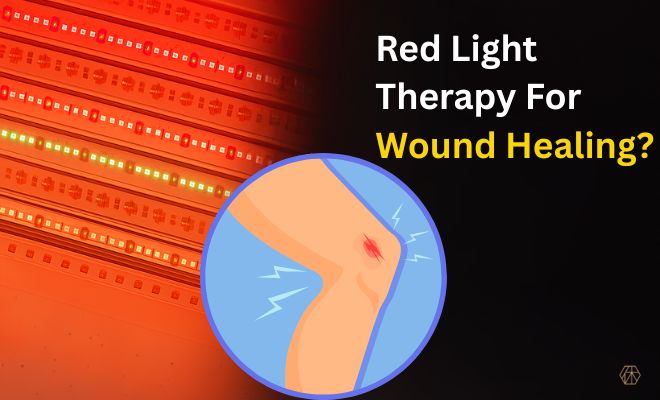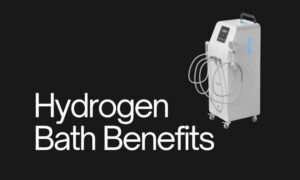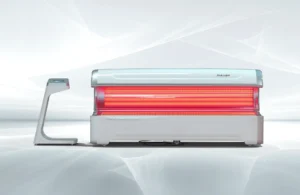Wound healing is more than just fixing the skin. It’s a complex process where the body works hard to control inflammation, rebuild tissue, and repair damage. While most minor wounds heal on their own, some, like diabetic ulcers, surgical cuts, burns, and pressure sores, can take much longer. These slow-healing wounds aren’t just uncomfortable; they can lead to infections, reduced quality of life, and increased healthcare costs.
This is where Red Light Therapy (RLT), also known as Photobiomodulation (PBM), comes into play. This non-invasive, drug-free technology is gaining recognition for its ability to accelerate wound healing, reduce inflammation, and minimize scarring. Whether you’re managing a stubborn sore or recovering from surgery, RLT could be a game-changing tool in your healing journey.
Let’s explore what red light therapy is, how it helps heal wounds, the supporting science, and how you can use it effectively.
What Is Red Light Therapy?
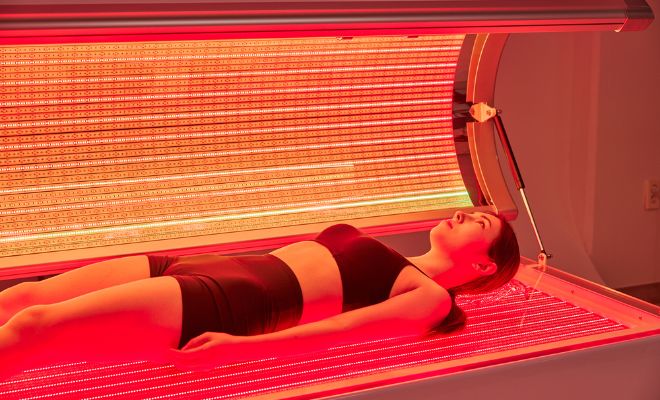
Red light therapy involves the application of low-level light in the red (620–660 nm) and near-infrared (810–850 nm) spectrum directly onto the skin. Unlike UV light, which can damage skin, these wavelengths are non-ionizing and therapeutic.
The real power of RLT lies in its ability to stimulate mitochondrial function. The mitochondria absorb these specific wavelengths of light, particularly through an enzyme called cytochrome c oxidase, which leads to increased production of adenosine triphosphate (ATP).
More ATP means faster and more efficient cellular repair, replication, and defense; key components in the wound healing process.
RLT is painless, doesn’t generate heat, and is suitable for daily or frequent use, making it a practical addition to most wound care protocols.
How Red Light Therapy Supports Wound Healing
1. Boosts Cellular Energy (ATP Production)
One of the key benefits of red light therapy (RLT) is its ability to boost ATP production, the energy source cells need to function properly, especially during wound healing. When a wound occurs, the surrounding cells often become stressed and energy-deprived, making it harder for them to do their functions, such as forming new tissue, activating the immune system, and producing important proteins and enzymes.
By increasing cellular energy, RLT helps these cells work more efficiently. RLT enhances their ability to:
- Divide and replicate to cover and rebuild tissue
- Migrate efficiently to the wound bed
- Synthesize collagen and other structural proteins
As a result, the entire wound healing process speeds up, helping tissue repair happen more quickly and with stronger results.
2. Reduces Inflammation
In a normal wound-healing process, inflammation is a short-lived phase that helps clear out pathogens and damaged tissue. But in chronic wounds, inflammation can linger, causing more harm than good.
Red light therapy helps modulate this by:
- Downregulating pro-inflammatory cytokines like TNF-α, IL-1β, and IL-6
- Encouraging anti-inflammatory signals like IL-10
- Preventing immune cell overactivation, which can damage healthy tissues
By restoring balance to the immune response, RLT shortens the inflammatory phase, allowing the body to move into tissue formation and remodeling more quickly. This can result in less swelling, pain, and tissue destruction, especially in conditions like diabetic ulcers or burns.
3. Stimulates Collagen Production
Collagen is the foundation of healthy skin and tissue. It provides structure, strength, and flexibility. Without sufficient collagen, wounds can reopen, or scar tissue can form improperly.
RLT enhances fibroblast proliferation, the cells responsible for producing collagen, elastin, and extracellular matrix proteins. This leads to:
- Stronger dermal layers
- Improved wound closure
- Reduced scarring and better cosmetic outcomes
For people recovering from surgery or burns, this collagen boost can significantly improve skin integrity and aesthetics.
4. Promotes Angiogenesis (New Blood Vessel Growth)
Re-epithelialization is a crucial step in wound healing where keratinocytes (the primary cells of the outer skin layer) migrate across the wound bed to form a new barrier. Without this process, wounds stay exposed, increasing the risk of infection and moisture loss.
Red light therapy (RLT) supports re-epithelialization by stimulating growth factors that promote keratinocyte activity, enhancing the migration of skin cells, and accelerating the restoration of the skin’s protective barrier. As a result, wounds close more quickly, the risk of infection decreases, and the newly formed skin becomes stronger and more resilient.
5. Accelerates Re-epithelialization
6. Antibacterial and Immune-Modulating Effects
Red light therapy doesn’t replace antibiotics, but it can help the body fight infection and support healing. Studies show that red and near-infrared light can boost the performance of immune cells, especially macrophages, which act like the body’s clean-up crew by removing harmful bacteria and dead tissue from the wound.
RLT also improves oxygen levels in the damaged area, which helps speed up recovery and makes it harder for bacteria to grow and spread. In wounds that are already infected or at high risk of infection, using RLT alongside traditional treatments, like antimicrobial dressings, can lower the number of bacteria and support faster healing. It works best as part of a complete care plan, helping the body strengthen its natural defense system while reducing the chances of complications.
Clinical Evidence for Red Light Therapy and Wound Healing
The scientific backing for red light therapy is robust and growing. Clinical studies and trials show that RLT improves:
- Time to wound closure
- Tissue elasticity and strength
- Reduced scarring and pigmentation
- Patient-reported pain and discomfort
Examples of Successful Applications:
- Diabetic foot ulcers: Studies report significantly faster closure and fewer complications.
- Pressure sores: RLT reduces size, depth, and infection risk.
- Burns: Accelerates healing and improves long-term skin texture.
- Surgical incisions: Patients experience less inflammation and better cosmetic results.
- Skin grafts: Support the integration and survival of transplanted tissue.
A 2022 meta-analysis in Lasers in Medical Science reviewed 30+ trials and concluded that PBM is both clinically effective and cost-efficient for wound care.
How to Use Red Light Therapy for Wound Healing
1. Wavelength and Device Type
- Red light (630–660 nm) is ideal for surface-level wounds—cuts, burns, and abrasions.
- Near-infrared light (810–850 nm) penetrates deeper—ideal for deep tissue injuries, muscle tears, or surgical wounds.
2. Treatment Protocol
Start treatment as soon as possible, ideally within hours or days of the wound. For chronic wounds, begin anytime.
Dosage and Frequency:
- Energy Density (Fluence): 4–10 J/cm² per session
- Session Time: 5–20 minutes, based on wound size/depth
- Frequency: Daily or every other day for acute wounds; 3–5x/week for chronic wounds
Always follow your device’s manual and, for complicated wounds, consult with a wound care specialist.
3. Treatment Positioning
To ensure maximum benefit:
- Distance: 1–6 inches from wound surface
- Angle: Perpendicular for even light distribution
- Contact: Avoid direct contact unless the device is sterile and approved for such use
If the wound is open, consider placing a sterile, transparent dressing (e.g., Tegaderm) over it to allow light through while protecting from contamination.
Safety and Contraindications
Red light therapy is generally safe with very few reported adverse effects. However, some precautions are necessary:
Avoid RLT:
- Directly over malignant tumors
- Overactive infections without medical supervision
- Near the eyes without protective goggles
Potential Side Effects:
- Temporary redness or tingling
- Mild skin warmth
- Rare: overstimulation or discomfort with prolonged use
Integration with Conventional Wound Care
Red light therapy should complement, not replace, established wound care techniques. For best results, combine with:
- Cleaning and debridement: Keeps the wound clear of dead tissue and biofilm.
- Antibiotics or antimicrobial dressings: Especially in infected wounds.
- Nutritional support: Protein, zinc, and vitamin C play major roles in tissue repair.
- Pressure offloading: For ulcers, ensure that the affected area is protected from repeated pressure.
This integrated approach ensures RLT is supporting—not masking—the natural healing process.
Support Wound Healing with HueLight’s Whole Body Photobiomodulation Chamber
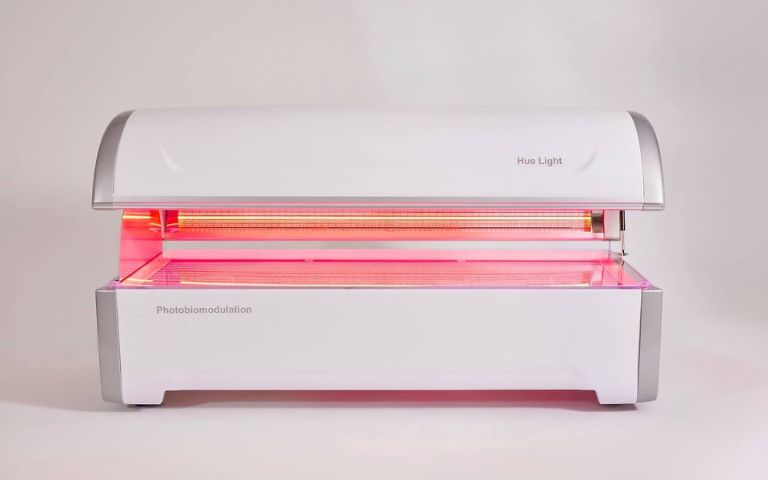
If you’re recovering from a stubborn wound, surgical incision, or chronic skin injury, HueLight’s Whole Body Photobiomodulation (PBM) Chamber offers a non-invasive, science-backed solution to support faster healing and reduce complications.
This full-body system uses over 40,000 medical-grade red and near-infrared LEDs to stimulate cellular energy, reduce inflammation, and promote tissue regeneration, all in just 20-minute sessions. It’s trusted by hospitals and clinics worldwide and is safe for daily use.
Whether you’re dealing with a hard-to-heal ulcer or want to enhance recovery after surgery, our PBM chamber helps your body heal more efficiently, naturally, and without drugs.
Ready to Take the Next Step?
Contact us today to learn how HueLight’s Whole Body PBM Chamber can support your wound healing journey. Our team is here to guide you and answer any questions you have.
